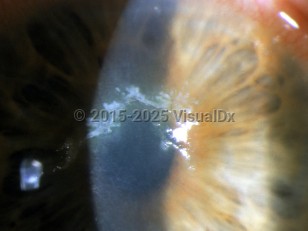Emergency: requires immediate attention
Herpes zoster ophthalmicus in Child
See also in: External and Internal EyeAlerts and Notices
Important News & Links
Synopsis

Herpes zoster ophthalmicus (HZO) is a reactivation of a latent infection with the varicella-zoster virus (VZV) in the distribution of the ophthalmic branch of the trigeminal nerve (V1). Classically, this reactivation occurs in healthy patients in or beyond their sixth decade. HZO is also more common in patients who are debilitated due to illness, trauma, stress, or immunosuppression (secondary to chemotherapy / medications, HIV infection, radiation, malignancy, etc).
Early symptoms include dysesthesias of the forehead and brow, along with headache, fever, fatigue, and eye pain. A vesicular rash that respects the midline can then develop, involving the forehead, brow, and eyelids. Involvement of the tip of the nose (Hutchinson sign) increases the chances of ocular involvement by up to 75%. The rash can be quite severe or mild enough to be mistaken for acne.
A red eye on the involved side indicates ocular involvement. HZO often causes conjunctivitis and can involve other structures of the eye, causing keratitis, scleritis, uveitis, cranial nerve palsies, and, less commonly, retinitis and optic neuritis. Symptoms include eye pain, tearing, redness, and decreased vision.
Once the acute phase of HZO has healed, a chronic inflammatory course with frequent exacerbations can persist, causing progressive corneal scarring and neurotrophic keratoconjunctivitis. Long-term complications also include ocular hypertension, glaucoma, and cataract. Chronic recurrent HZO (long after the rash has healed) can be very difficult to treat and may lead to corneal scarring and neovascularization. Postherpetic neuralgia can also be a very difficult situation for both patients and physicians to deal with. Cerebrovascular accidents have been associated with zoster.
Early symptoms include dysesthesias of the forehead and brow, along with headache, fever, fatigue, and eye pain. A vesicular rash that respects the midline can then develop, involving the forehead, brow, and eyelids. Involvement of the tip of the nose (Hutchinson sign) increases the chances of ocular involvement by up to 75%. The rash can be quite severe or mild enough to be mistaken for acne.
A red eye on the involved side indicates ocular involvement. HZO often causes conjunctivitis and can involve other structures of the eye, causing keratitis, scleritis, uveitis, cranial nerve palsies, and, less commonly, retinitis and optic neuritis. Symptoms include eye pain, tearing, redness, and decreased vision.
Once the acute phase of HZO has healed, a chronic inflammatory course with frequent exacerbations can persist, causing progressive corneal scarring and neurotrophic keratoconjunctivitis. Long-term complications also include ocular hypertension, glaucoma, and cataract. Chronic recurrent HZO (long after the rash has healed) can be very difficult to treat and may lead to corneal scarring and neovascularization. Postherpetic neuralgia can also be a very difficult situation for both patients and physicians to deal with. Cerebrovascular accidents have been associated with zoster.
Codes
ICD10CM:
B02.30 – Zoster ocular disease, unspecified
SNOMEDCT:
87513003 – Herpes zoster ophthalmicus
B02.30 – Zoster ocular disease, unspecified
SNOMEDCT:
87513003 – Herpes zoster ophthalmicus
Look For
Subscription Required
Diagnostic Pearls
Subscription Required
Differential Diagnosis & Pitfalls

To perform a comparison, select diagnoses from the classic differential
Subscription Required
Best Tests
Subscription Required
Management Pearls
Subscription Required
Therapy
Subscription Required
References
Subscription Required
Last Reviewed:08/13/2019
Last Updated:05/03/2021
Last Updated:05/03/2021
Emergency: requires immediate attention
Herpes zoster ophthalmicus in Child
See also in: External and Internal Eye
